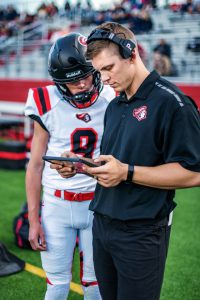We cannot deny that technology has made our lives so much easier. We can now safely place online bets using skybet sign up offer or stream whichever movie we want to watch and all that without even leaving the couch. Sports are not excluded from this upgrade. Gone are the days when it was about just natural talent and hand-eye coordination. Now sports rely heavily on technology – be that tracking Nike kicks or analyzing the performance of an athlete. Yet, people don’t always know what technologies are used in sports and how they’re used. Let’s look at some examples.
Wearable tech
 Wearable technology is one example of how technology has been used to improve sports. Fitness trackers, smartwatches, and other fitness-related wearable tech have been used by athletes for years. They help the athletes measure their performance and set new goals. Athletes can use these devices to monitor their heart rates, hydration levels, distance traveled, as well as many other metrics.
Wearable technology is one example of how technology has been used to improve sports. Fitness trackers, smartwatches, and other fitness-related wearable tech have been used by athletes for years. They help the athletes measure their performance and set new goals. Athletes can use these devices to monitor their heart rates, hydration levels, distance traveled, as well as many other metrics.
Sensors
With sensors, you can get real-time feedback on your progress, which means that you can use that data to make adjustments while you’re playing. And it’s not just athletes who are benefiting from this—coaches too! Coaches can use the data collected by sensors as part of their strategy for training athletes on how best to perform in-game situations.
Sensors also improve sports by improving safety for athletes. For example, sensors can be used to track how hard a player gets hit during a game and whether or not the impact is high enough that the player may sustain a concussion. Coaches are alerted when an athlete is hit too hard and they can then remove them from the game immediately.
Instant replay
 Instant replay is a great example of how technology is improving sports. Before the advent of instant replay, referees called plays based purely on what they saw at the time, and sometimes their judgment was faulty. This has had a huge impact on the game—the wrong call can result in a time-out, a loss of points, or even a loss of possession. These mistakes are heartbreaking for fans and devastating to players. And in tight games affected by these calls, fans may feel that the outcome was unfair. However, with instant replay technology, officials can look back to make sure their calls are right. Players can rest assured that they’re not being unfairly penalized for a mistake they didn’t make. And the game is fairer overall.
Instant replay is a great example of how technology is improving sports. Before the advent of instant replay, referees called plays based purely on what they saw at the time, and sometimes their judgment was faulty. This has had a huge impact on the game—the wrong call can result in a time-out, a loss of points, or even a loss of possession. These mistakes are heartbreaking for fans and devastating to players. And in tight games affected by these calls, fans may feel that the outcome was unfair. However, with instant replay technology, officials can look back to make sure their calls are right. Players can rest assured that they’re not being unfairly penalized for a mistake they didn’t make. And the game is fairer overall.
Disability
Technology has made sports available to more people than ever before. This includes people with disabilities, as well as those who have less access to traditional sports for a variety of reasons.
In the Paralympics, athletes can compete in the same events that able-bodied athletes do, but with different rules and technology adaptations. Take the recent FINA World Championships in Gwangju, South Korea: the competition allowed deaf swimmers to compete alongside their hearing counterparts using lights and vibrations, instead of sound. This meant that they could swim, race, and compete without any one type of swimmer being at an inherent disadvantage to their opponents.
It is especially important that disabled athletes have access to sports because of the health benefits they get from it. From an article on Business Insider: “The risk of death among individuals with physical disabilities who were active was more than 50% lower than their inactive counterparts.”
